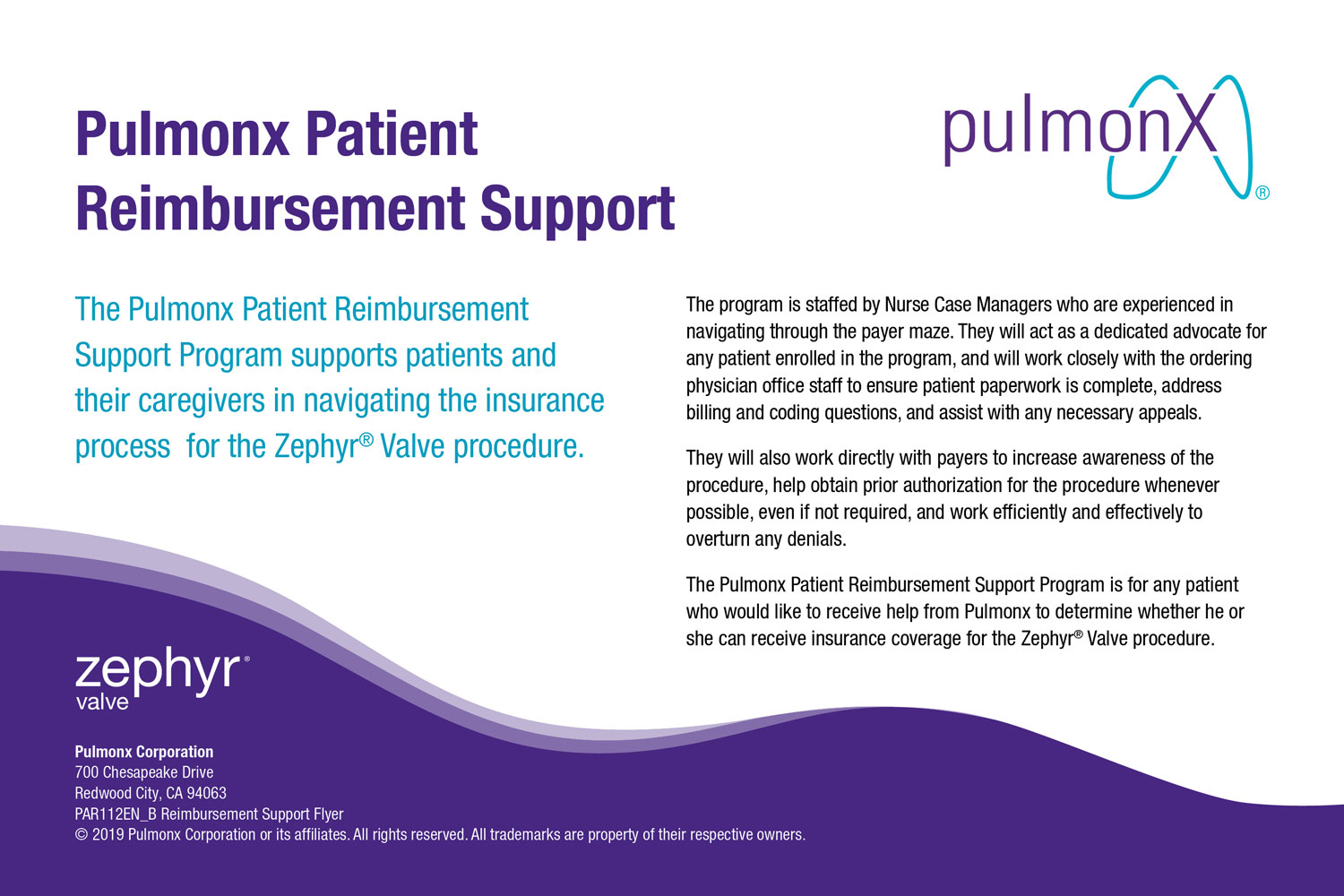U.S. Reimbursement Resources
Pulmonx is dedicated to supporting healthcare providers, associated facilities and their patients as they navigate through the reimbursement process and educate payers on the Zephyr® Valve procedure. Commonly requested information related to the reimbursement process for the Zephyr Valve procedure is provided below.
For providers or hospitals interested in speaking with a reimbursement representative in more detail about reimbursement associated with the Zephyr Valve procedure, please contact us.
Breakthrough Technology
The device was granted a “breakthrough medical status” and approved by the FDA on June 29, 2018 because —
The device intends to treat patients with severe emphysema, an irreversible and life-threatening progressive disease. This represents a breakthrough technology as the device offers bronchoscopic lung volume reduction without surgery and its associated risks. This device offers significant clinically meaningful advantage over the current standard of care and therefore its availability is also in the best interest of patients.”
Approved Indication
The Pulmonx Zephyr Endobronchial Valves are implantable bronchial valves indicated for the bronchoscopic treatment of adult patients with hyperinflation associated with severe emphysema in regions of the lung that have little to no collateral ventilation.
Coding
For additional information about possible coding and payment related to the Zephyr Valve procedure, download a copy of the Pulmonx Coding Guide here.
Published clinical evidence can be found by clicking the button below.
Inclusion in relevant Guidance Documents on the treatment of emphysema can be found by clicking the button below.
Coverage
Zephyr Valves are Food and Drug Administration (FDA) approved. Providers should contact their individual payers prior to performing the Zephyr Valve procedure for information on coverage.
Medicare
Currently we are unaware of a National Coverage Determination (NCD) or Local Coverage Determination (LCD) for the Zephyr Valve procedure. It is the responsibility of the provider to confirm current Medicare policies prior to administering the service to Medicare beneficiaries. When no policy exists, Medicare coverage determinations can be based on Medicare’s “reasonable and necessary” requirement.*
Non-Medicare
The number of commercial payors covering the procedure is growing. As of December 2019, commercial payors such as Aetna, Humana, Priority Health and Emblem Health have issued positive coverage policies for endobronchial valve procedures. United Healthcare has not issued a policy specific to endobronchial valve procedures but has removed related procedure codes from their “non-covered” list, and as such no longer considers the procedure unproven or experimental. Other commercial payors are still learning about the procedure and published evidence and do not yet consider the procedure medically necessary. Many of these same plans, however, are approving pre-authorization requests on a case-by-case basis.
Regardless of the payer, Pulmonx always recommends seeking a pre-authorization approval whenever possible prior to performing the Zephyr Valve procedure.
Patient Reimbursement Support Program
For patients who qualify for the procedure, the Pulmonx Patient Reimbursement Support Program is available to patients and their caregivers as they navigate the insurance process for the Zephyr Valve procedure. The program is staffed by case managers who are experienced in navigating through the payer maze. They will act as a dedicated advocate for any patient enrolled in the program and will work closely with the ordering physician office staff to ensure patient paperwork is complete, address billing and coding questions, and assist with any necessary appeals.
* Under Medicare, a service is considered reasonable and necessary if it is:
-
Safe and effective
-
Not experimental or investigational
-
Appropriate, including the duration and frequency that’s considered appropriate for the item or service, in terms of whether it’s:
-
Furnished in accordance with accepted standards of medical practice for the diagnosis or treatment of the patient’s condition or to improve the function of a malformed body member;
-
Furnished in a setting appropriate to the patient’s medical needs and condition;
-
Ordered and furnished by qualified personnel;
-
One that meets, but does not exceed, the patient’s medical need; and
-
At least as beneficial as an existing and available medically appropriate alternate
-


